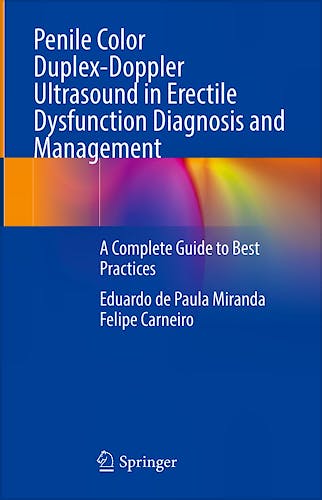

There are no products in the cart.



Penile Color Duplex-Doppler Ultrasound in Erectile Dysfunction Diagnosis and Management. A Complete Guide to Best Practices
Miranda , E. — Carneiro, F.
1ª Edition April 2024
English
Hard Cover
191 pags
800 gr
18 x 26 x 1 cm
ISBN 9783031556487
Publisher SPRINGER
Printed Book
-5%
135,19 €128,43 €VAT included
129,99 €123,49 €VAT not included
Receive it within
2 - 3 weeks
Electronic Book
-5%
124,79 €118,55 €VAT included
119,99 €113,99 €VAT not included
OnLine Access
Immediate
1. History of Functional Assessment of Penile Erection
2. Principles of Doppler Ultrasound
3. Minimum Requirements for an Ultrasound Machine, Basic Setup, and Adjustments for Penile Hemodynamic Studies
4. Penile Anatomy and Physiology of Erection
5. Clinical Aspects of Erectile Dysfunction
6. The Role of Penile Doppler Ultrasound in the Diagnosis and Management of Erectile Dysfunction
7. Pharmacotherapy for Inducing an Erection
8. Penile Rigidity Assessment
9. Audiovisual Sexual Stimulation During Hemodynamic Evaluation of the Penis
10. Erection Reversal Protocols and Management of Prolonged Erections
11. Evaluation of Penile Deformities in the Erect State of the Penis
12. Interpretation and Clinical Implications of Penile Hemodynamic Parameters
13. Step-by-Step Guide for Penile Doppler Ultrasound Examinations: Practical Tips
14. Limitations of Penile Hemodynamic Studies with Doppler Ultrasound
15. Applicability of Additional Penile Investigation Modalities Using Ultrasound Devices
16. Optimizing Written Medical Reports
17. Sample of Case Studies
Penile Color Duplex-Doppler Ultrasound (PDU) is one of the most important tools available to assess patients with erectile dysfunction (ED), which is a prevalent condition affecting near 50% of men over 50 years of age. Hemodynamic evaluations through PDU have also prognostic value and help choose the best treatment strategy for ED.
Although PDU is an objective diagnostic method, the lack of standardized protocols is one of its main limitations and might lead to great variability in performing and interpreting penile hemodynamic studies in both clinical practice and scientific research. These factors have contributed to the fact that PDU is often considered unreliable, as it may lead to mistaken treatment protocols.
The aim of the present book is to provide a complete guide to performing an adequate hemodynamic study through PDU with pharmaco-induced erection. It will provide a detailed and illustrative overview of the most common pitfalls for a correct conduction ofthis diagnostic procedure. We will also provide an extensive review of the basic principles in erection physiology and pharmacology, allowing a broader understanding of the implications of PDU in clinical practice.
This book will appeal to radiologists and urologists. Its highly informative content will become the ultimate guide not only for fully trained physicians who want to optimize and standardize their procedures, but also for residents and trainees of these specialties. In addition, it will be a useful resource for sexual medicine practitioners, and may reach other specialties and/or healthcare areas such as primary care physicians, gynecologists, psychiatrists and psychologists.
Eduardo de Paula Miranda
Dr. Miranda has obtained his MD degree from the University Federal do Ceará in 2008 and has finished a residency training in Urology from 2010 to 2015 at the University of São Paulo. In addition, he has completed his PhD in Urology at the University of São Paulo in 2016. He completed a fellowship training in Sexual & Reproductive Medicine at Memorial Sloan Kettering Cancer Center (MSKCC) in 2017. Dr. Miranda is involved in numerous clinical and research activities in the field of Andrology, Sexual Medicine and Male Infertility. He is currently working as an attending urologist and associate professor at Centro Universitario Christus (UNICHRISTUS) in Fortaleza, Brazil.
Felipe Carneiro
Dr. Carneiro has obtained his MD degree from the University of São Paulo in 2009 and completed a residency in Radiology at the same institution in 2014. Since then he has been devoted to the study and practice of penile Doppler ultrasound examination. He has obtained a PhD degree in 2018 after conducting a study about the importance of audiovisual sexual stimulation during penile Doppler evaluation. He also has international experience with clinical training at Memorial Sloan Kettering Cancer Center (MSKCC) in 2018. Dr. Carneiro has been involved in numerous activities in the field of Sexual Medicine, mainly performing penile hemodynamics in both research and clinical settings. He is currently working as an attending radiologist for the Radiology Department at the University of São Paulo.
© 2025 Axón Librería S.L.
2.149.0